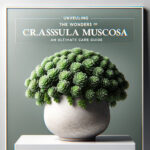Welcome to our crash course on Crassula alpestris, a verdant gemstone in the panorama of succulents! Let’s embark on a journey to discover the captivating allure of this often overlooked plant.
Unraveling the Appeal of Crassula alpestris
You might be familiar with popular succulent types like Aloes and Agaves, but get this – Crassula alpestris gives these ubiquitous types a run for their money. In the grand tapestry of succulents, Crassula alpestris weaves its own unique beauty. The allure boils down not just to its charming, compact structure but also to its adaptability and minimal care requirements.
A Stroll Down History Lane: The Origins of Crassula alpestris
Crassula alpestris’s history is truly as captivating as the plant itself. Tracings of its origins lead us back to the arid, stunning landscapes of South Africa. Their ability to withstand harsh climates is indeed a testament to their hardiness. Today, it’s exciting to find these special succulents finding homes in windowsills and gardens around the globe.
Crassula alpestris in its Natural Habitat
So, where does Crassula alpestris naturally thrive? Picture this – a rocky mountainside in South Africa, bathed in intense sunlight, getting by on just spatters of rain. Yes, this is Crassula alpestris’s homeland. This resilient little plant thrives in nutrient-poor soils, handling the extremes with a charm only it can muster. Its ‘life-on-the-edge’ existence plays a role in shaping its distinctive features, like the small clustered leaves that function as excellent water stores during extended dry periods.
In conclusion, the Crassula alpestris may be a smaller name in the realm of succulents, but in no way should it be underestimated. A product of a tough and challenging environment, it’s famed for its durability and charm, making it a distinctively unique variety. This hardy and handsome succulent truly warrants a prominent spot in your plant collection.
Let’s dive right in with “Understanding the Characteristics of Crassula alpestris.” After all, understanding the physical traits, growth habits, and the critical differences compared to other Crassula species will make the journey of growing this succulent quite a thrill. So, strap in as we embark on this detailed exploration of the enchanting Crassula alpestris.
Physical Traits
Now, let’s talk about what makes Crassula alpestris a veritable eye-catcher. For starters, it’s a relatively small succulent, usually not growing over 12 inches in height. However, it’s the plant’s leaves that truly steal the show. Clusters of sea-green, almost heart-shaped leaves, banded with a striking red line along the edges, give this plant a distinctive, unmissable charm.
Blooming season? That’s another breathtaking spectacle. When the Crassula alpestris flowers usually between late winter and spring, it adorns itself with captivating clusters of tiny, star-shaped pink flowers, making it a truly mesmerizing sight.
Growth Habits of Crassula alpestris
The growth habits of Crassula alpestris uniquely complement its physical charm. It has a relatively slow growth rate and thrives in well-draining soil. It’s sun-loving in nature, but be careful not to expose it to intense midday sun, as it can easily get sunburned.
A fascinating fact is how adaptable Crassula alpestris can be when it comes to temperature. It can withstand relatively cold temperatures down to 30 degrees Fahrenheit. However, if you live somewhere with harsh winters, it’s a good idea to pot your Crassula alpestris, so you can bring it indoors when Jack Frost comes knocking.
Comparing Crassula alpestris to Other Crassula Species
When we put Crassula alpestris side by side with other Crassula species, it holds its own impressively. Take the well-known Crassula ovata, or Jade Plant, for instance. While the Jade Plant is renowned for its unique bonsai-like growth habits and woody stems, the Crassula alpestris stands out with its distinctive leaf design and charismatic rosettes.
Crassula alpestris has a different kind of appeal compared to Crassula arborescens, or Silver Dollar Plant. While the latter is famed for its round, blue-grey leaves, the former charms us with its vibrant sea-green leaves and clusters of pink flowers in the blooming season. It’s safe to say, each Crassula species has strengths, but there’s something undeniably captivating about the Crassula alpestris!
So, whether you’re a seasoned gardener or a beginner succulent enthusiast, Crassula alpestris can indubitably add a touch of charisma to your succulent assortment. Its physical attributes, unique growth habits, and point of difference from other Crassula species all contribute to its appeal as a “Hidden Gem” in the succulent variety.
Properly Planting Your Crassula alpestris
So, you’ve decided to add a Crassula alpestris to your succulent collection–good choice! Let’s jump directly into how to provide this unique plant the perfect home. Just like people, plants thrive in the right conditions, and our dear Crassula alpestris is no different.
Prime Conditions to Plant
Before you grab your trowel and start digging, think about the ideal spot for your Crassula alpestris. It prefers a moderately sunny spot, but avoid direct, scorching rays. Think of a porch that gets soft morning sunlight. Too much sun can cause the leaves to scorch, and you definitely don’t want a sunburnt Crassula alpestris–ouch!
It may sound counterintuitive, but temperature plays an underrated role. Your Crassula alpestris is a tough cookie. It can withstand temperatures as low as 30°F (-1°C), but really prefer the temperature range between 65-75°F (18-24°C). So if you’ve got a heated sunroom, your Crassula alpestris is going to be pretty happy.
Preparing the Soil
So, we’ve sorted the light and temperature, but what about the soil? Well, just like you’d prepare a comfy bed for a good night’s sleep, the Crassula alpestris needs the right soil to thrive. It’s all about balance. Your Crassula alpestris wants a well-draining soil mix to avoid waterlogged roots–nobody likes wet feet for too long, right? Consider a succulent mix, combining potting soil with sand and perlite. This provides an optimal balance of moisture retention and drainage, a nirvana for roots!
Remember, like preparing a meal for guests, the soil preparation is crucial. Ensure you have a pot with substantial drainage holes. This provides excessive water an escape route, preventing your Crassula alpestris from sitting in soggy soil. Your plant will thank you for it!
With the right conditions in place, your Crassula alpestris will be a happy camper, enhancing your garden or home with its unique charm. Remember, perfect planting is about creating a suitable environment. With the right care, your Crassula alpestris will surely reward you with its stunning growth. Ready to start planting?
Let’s dive into the details of Crassula alpestris care. These charming succulents, with their emerald-green cascades of miniaturized leaves, demand a bit of special attention in return for their alluring aesthetics. Much like people, they have their likes and dislikes when it comes to watering, fertilization, grooming, and disease and pest management. Nailing down their care needs is like a satisfying puzzle – once you get the jigsaw pieces correctly, the result is truly worthwhile. So, let’s get started on understanding the right care techniques for your Crassula alpestris.
Watering Your Crassula alpestris
Watering needs can feel a bit tricky when dealing with succulents like Crassula alpestris. The rule of thumb is – these tiny green sunseekers prefer neglect over pampering. So, overwatering is a definite no-no. Their watering schedule should follow the classic “soak and dry” method, meaning the soil should be made wet thoroughly and then allowed to dry out completely before the next watering. Following this technique, your Crassula alpestris can prevent waterlogged roots, which can lead to root rot. Remember, these succulents are naturally designed to survive in arid environments, so when in doubt, always err on the side of too little water rather than too much.
Fertilizing
When it comes to nutrients, you might think more is merrier but hold on. Crassula alpestris do not need heavy fertilizing. A light feeding during the growing season, typically in the spring and summer, is ample. Use a water-soluble, succulent-specific fertilizer and always follow the package instructions for dilution rates. You’ll want to reduce, or completely pause, fertilizing during late fall and winter when the plant goes into its rest period. Remember, moderation is key here.
Grooming
Grooming a Crassula alpestris isn’t a demanding task. You’ll simply want to remove any leaves that appear shriveled, dried out, or yellowing. This practice not only tidies up your plant but also helps keep it healthy by minimizing the chance of disease and pest infestation. So, keep an eye out for any “off” leaves – your Crassula alpestris will thank you!
Dealing with Diseases and Pests
No matter how much you love your Crassula alpestris, pests and diseases might do as well – however, they’re not the kinds of pals you want for your succulent. Common issues can include mealybugs, spider mites, or fungal diseases. Prevention is the best medicine – so a well-draining soil, good airflow, and not overwatering are top guards against these nuisances. But if you do spot a problem, don’t panic! There are plenty of organic and chemical solutions available to help restore your Crassula alpestris’ health.
There you have it – a comprehensive guide to keeping your Crassula alpestris happy and healthy. With the correct watering and fertilizing routine, some light grooming, and vigilant disease and pest control, you’ll enjoy the lush beauty of this succulent for years to come.
Propagating Your Crassula alpestris
Creating your own lush oasis using Crassula alpestris is much easier than you think. By the end of this segment, you’ll be able to turn a single Crassula alpestris into an entire family of green jewels. There are three main methods to achieve this: stem propagation, leaf cuttings, and seeds. Let’s delve into each of them.
Stem Propagation
Stem propagation is perhaps the most straightforward method to propagate your Crassula alpestris. Here’s a quick step-by-step guide:
Step one: Select a healthy stem
For successful propagation, you should scar a healthy stem. Ideally, it should be about two to three inches long. Don’t be shy; your mother plant will survive the “surgery”.
Step two: Let it dry
Once you’ve chosen your stem, carefully snip it off and let it dry. Remember, succulents thrive in arid conditions, so this drying process is vital to kick-start the rooting process.
Leaf Cuttings
Taking leaf cuttings is another excellent way to propagate your Crassula alpestris. You essentially follow the same steps as stem propagation, but this time using a healthy leaf. After cutting it off and allowing it to dry, simply place it on top of cacti soil and wait. When watering, remember less is more; overwatering can lead to rot.
Using Seeds
If you’re a patient gardener, propagating Crassula alpestris from seeds is a viable option. It might require more time than the other two methods, but the reward of seeing new growth sprout from tiny seeds is often worth the wait.
Start by acquiring Crassula alpestris seeds. Then, plant them in cacti soil, ensuring that they’re just below the surface. Water them conservatively and provide lots of gentle sunlight. With time, you should see tiny green sprouts appear.
Best Time to Propagate
Now that you’re armed with the propagation methods let’s talk timing. The best time to propagate Crassula alpestris is during the warmer months, particularly early spring. The growing season offers optimal conditions for propagation. Nevertheless, with the correct setup, you can attempt propagation at any time of the year.
In conclusion, the propagation of Crassula alpestris may seem daunting at first, but armed with a decent pair of shears and a bit of patience, you’ll be witnessing your very own Crassula alpestris nursery in no time!
The Significant Role of Crassula alpestris in Home Decor
The world of interior design is a treasure trove filled with diverse pieces crafted to enhance the aesthetics of homes. Among these, one notable gem is the Crassula alpestris. This dynamic succulent has been steadily growing in popularity, becoming an in-demand accent for home decor with its unique structure and refreshing appearance. From windowsills to coffee tables, let’s discover how the Crassula alpestris can dazzle as an addition prop to your decor lineup.
Invigorating the Atmosphere with Crassula alpestris
Imagine sitting in your living room. As your eyes gently scan around, they land on a beautiful cluster of Crassula alpestris tastefully arranged on your side table. With vibrant green foliage that subtly transitions to a warm rosy hue at the tips, the sight of these succulents inspires a sense of rejuvenation and tranquility.
Whether placed on a shelf against a plain wall, or on a centerpiece tray alongside an array of coffee table books, the Crassula alpestris does more than merely occupy space. They breathe life into their surroundings, offering a refreshing visual nugget amidst your everyday elements.
Unleash Creativity with Crassula alpestris
Crassula alpestris can inject fun and creativity into your home decor in ways you might not have considered. Have a mason jar lying around from your last DIY project? Fill it up with some soil, and voila! You have a chic new home for your Crassula alpestris. Group them together with different succulents, and you’ve got a mini indoor garden that adds a burst of freshness to your workspace.
Moreover, these magnificent plants can serve as organic elements in your minimalist decor scheme. A single, carefully nurtured Crassula alpestris can stand tall, adding a dash of uniqueness to a clean, modernistic ensemble, whilst also cementing your green thumb status!
The Aesthetically Pleasing Crassula alpestris in Home Decor
There’s a simple elegance to the Crassula alpestris that’s hard to miss. With their compact size, lush texture, and their ability to thrive with minimal care, these succulents are more than just a plant – they’re a virtual style statement.
From rustic interiors to clean-lined contemporary homes, no style is too challenging for Crassula alpestris. These versatile houseplants can adapt and complement any given ambiance, leaving an aesthetically pleasing and subtly impressive mark on onlookers.
To sum up, the Crassula alpestris ignites a unique spark in home decor. It stands as a testament that incorporating elements of nature into one’s living space enhances not only the aesthetics but also the mood, and the overall vibe. An ode to understated elegance and simplicity, make the Crassula alpestris the essential piece in your home decor narrative today.
Where to Buy Crassula alpestris
Let’s unlock the not-so-secret garden of acquiring this hidden gem of a plant, the Crassula alpestris. Whether you’re an online shopping savant or a local store loyalist, opportunities abound to add this gem to your succulent collection.
Online Shopping for Crassula alpestris
Digital shopaholics, rejoice! Crassula alpestris is absolutely attainable via your favorite online shopping platforms. Sites like eBay, Amazon, and Etsy are teeming with succulent sellers who can deliver this delightful plant right to your door. Specialized online nurseries and plant shops, such as Mountain Crest Gardens or Leaf & Clay, also offer a selection of Crassula alpestris. When buying online, always check customer reviews and choose a seller with a good track record to ensure you’re getting a healthy specimen.
Hitting the High Street
Brick-and-mortar enthusiasts, fear not! Plenty of local garden centers and nurseries stock the Crassula alpestris. If they don’t have it, remember, it never hurts to ask. They may just need to order it in for you. When choosing a healthy Crassula alpestris at a local store, look for plants with rigid, bright green leaves. Wilted, yellowing, or fallen leaves may indicate an unhealthy plant. Give a leaf a gentle squeeze – it should feel firm, not soft and squishy.
Tips for Choosing Healthy Crassula alpestris
Whether you’re buying online or in-store, proper plant selection can be the difference between a flourishing Crassula alpestris and a finicky, failing one. Choose plants with fresh, bright green foliage that shows no signs of damage or disease. Look for signs of good root health, such as a well-anchored plant and fresh growth around the base. Be wary of plants with signs of root rot, like a wobbly base or mushy, blackened roots. The more you know about what makes a healthy Crassula alpestris, the happier your plant – and you – will be.
Remember, taking the plunge and buying a Crassula alpestris is just the first step in your journey with this charming succulent. Proper care and attention will be key to its success. With the right knowledge and resources, you’ll be well on your way to cultivating a thriving Crassula alpestris of your own.
Crassula alpestris – Frequently Asked Questions
Are you a succulent enthusiast, green thumb hobbyist, or simply fascinated by the stunning beauty of the Crassula alpestris? Then, this FAQ section is surely for you! Allow us to quench your curiosity and help you get a better grasp of this splendid plant.
How to Care for Crassula alpestris?
First and foremost, the fundamentals. Caring for an alpestris is actually quite straightforward. They are pretty independent beings requiring minimal fuss. They love well-draining soil, and a container with drainage holes is perfect. A general rule of thumb: underwatering is better than overwatering. When in doubt, less is more! Also, these little gems love the morning sun but keep them out of harsh afternoon sunlight; it will damage their leaves.
How to Propagate this Succulent?
Speaking of gem-like qualities, propagation is where Crassula alpestris really shines. You can duplicate your favorite plant with just a section of its leaf! Simply remove a leaf from the mother plant, let it dry for a couple of days, and then place it on well-draining soil. Be patient though, roots may take a few weeks to appear. Once they do, you’ll have a new little young Crassula ready to grow.
Common Issues Encountered with Crassula alpestris
Like all plants, our little alpestris can experience its fair share of difficulties. The most common, as with many succulents, is overwatering. This typically manifests as yellow or brown leaves. Remember, alpestris would rather be under-watered than overwatered. Pests can be a challenge too, but using a diluted natural soap as a pesticide usually does the trick.
What More Should I Know About Crassula alpestris?
Capping off our FAQ, we encourage everyone to try their hand at growing a Crassula alpestris. They are a delightful addition to any plant collection with their aesthetic appeal and easy-to-care-for nature. Surely, they reward every plant parent, from novice to experienced, with their serene beauty and resilience.
So, are you ready to explore the captivating world of Crassula alpestris? Go ahead, step into the enchanting land of succulents, and let your green thumb touch the life of this fascinating plant.



